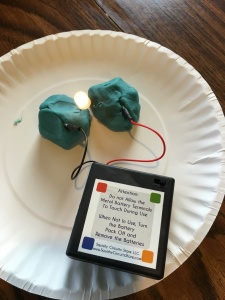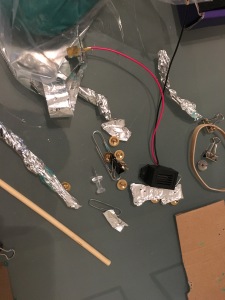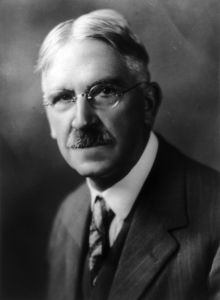Part 1: Squishy Circuits
I think one of my dad’s proudest moments was when I asked him to help me make this light blink on:

Squishy Circuits is a simple kit that is designed for kids to learn about how electricity works. The kit comes with a battery back, LED lights, a motor and a couple of buzzers. The best part is that instead of wires, you set up your circuits using homemade salt dough. After watching videos of several third graders successfully making circuits, I decided that this was the ideal kit for me to use in my next assignment.
What follows is the story all about how my Squishy Circuits circuit…didn’t work. At least, not at first.
I made the conductive dough:
And then the insulating dough:
And I set up my first circuit and…nothing.
I moved some pieces around and…nothing.
“Dad, could you help me?”
As an electrical engineer, there is nothing my dad likes better than to teach other people about electronics. Apparently multimeters are pretty useful, and he showed me how to test voltage, amperage, and conductivity. Eventually, we deduced that we had a faulty mechanical connection in the red wire in the battery pack. My dad even proposed an elegant solution: a hammer and a firm surface. Forty minutes of testing and ten seconds of smashing later, the mechanical connection wasn’t going anywhere, and I had light!

Part 2: Experimenting
Now, on to Part 2 of my project! I had to find a few household items and integrate them with my Squishy Circuit kit in order to make something that I could use with my students.
I had fun experimenting with different materials. Could I integrate paper clips into my circuit? Aluminum foil? Pushpins? Maybe I could make a scoreboard with a light at the top? Something with Batman v Superman? Something like the game Operation?

And as expected, I ran into a few other challenges as I experimented. My Squishy Circuit continued to be temperamental about whether or not it would decide to work and that was a major issue, because I couldn’t always tell if my circuit wasn’t working because I made an error, or because the kit wasn’t working. In addition, I had a lot of items to play with, but what I really needed was a long, thin wire to make my constructions more flexible.
Eventually, inspired by the game Operation and David Bowie, I came up with a maze game that I call ¡El laberinto de muerte!, or, The Labyrinth of Death!
Behold!
The idea is that one blindfolded student would use the stylus – a chopstick wrapped in aluminum foil and attached to the battery pack – to “run” through the maze, following the directions (in Spanish!) of their non-blindfolded partner. If they touch one of the walls of the stylus, then the circuit is completed and the Green Light of Death blinks on, and they lose. However, if they make it to the end of the maze, they escape to practice their verb conjugations another day.









